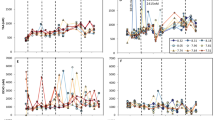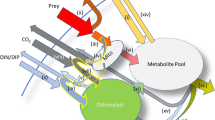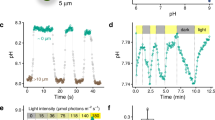Abstract
Bacteriochlorophylla (BChla)-based phototrophy cannot be ignored in understanding of carbon cycle in the ocean. However, the role of BChla relative to chlorophylla (Chla) along environmental gradients remains unclear. On the basis of the investigations in the Pacific, Indian Oceans and the China Seas, we show that the average contribution of BChla relative to Chla is higher in open-ocean compared with shelf environments, the estimated BChla-based phototrophy could reduce respiratory organic carbon consumption of 2.4% and 5.4% of the primary productions in the shelf and oceanic waters, respectively. This suggests that BChla-based phototrophy has an important role supplemental to Chla-based photosynthesis in the ocean's carbon cycle and would be critical for a marine region to be a sink or a source of atmospheric CO2.
Similar content being viewed by others
Main
With bacteriochlorophylla (BChla)-based light utilization function, aerobic anoxygenic photoheterotrophic bacteria (AAPB) are critical to our understanding of carbon and energy cycling in the ocean (Kolber et al., 2001; Eiler, 2006). Recent studies on the dynamics of AAPB in marine environments have suggested that AAPB are more abundant in eutrophic than oligotrophic waters (Jiao et al., 2007). As AAPB are primarily heterotrophic (Yurkov and Beatty, 1998) and their distribution pattern may be more determined by the availability of the dissolved organic carbon than by light (Jiao et al., 2007), we argue that the abundance or biomass of AAPB is primarily determined by heterotrophy and thus is not indicative of their phototrophy, which is critical for understanding of the role of AAPB as a special functional group in the community. At this juncture, the contribution of energy flow through BChla relative to that through chlorophylla (Chla) along large environmental gradients remains to be systematically elucidated.
In this study, simultaneous in situ measurements of BChla, Chla, AAPB abundance, photochemical efficiency, relative functional cross-section of photoreaction center and photosynthetic available radiation were carried out (methods given in Supplementary Information) in the Pacific and Indian Oceans, and the China seas (Figure 1) toward a better understanding of the relative significance of BChla-based phototrophy to Chla-based photosynthesis in shelf and oceanic environments, and possible impacts of BChla-induced solar energy utilization on carbon cycling in the surface ocean.
Distribution of bacteriochlorophylla (BChla) concentration (a) and BChla proportion (b) in the Pacific, Indian Oceans and the China seas (Aqua-MODIS remote-sensed chlorophylla (Chla) images were used as the background). Depth profile sites are indicated with white crosses. The inset plots in panels a and b show significant positive or negative correlations between AAPB abundance and BChla proportion with Chla concentration (logarithm transformed), respectively.
Bacteriochlorophylla concentrations were distinctly higher in the shelf waters (1.9–25.8 ng l−1) than in the oceanic waters (0.5–4.4 ng l−1) (Figure 1a, Supplementary Figure S1, Supplementary Table S1). Whereas, the proportion of BChla in total photosynthetic pigments (BChla/(BChla+Chla), ranging from 0.2% to 3.0%, had an opposite distribution pattern (Figure 1b, Supplementary Figure S1, Supplementary Table S1). AAPB abundance increased with increasing Chla concentration as shown by the regression analysis (r=0.65, n=201, P<0.01; Figure 1a inset plot), clearly showing that AAPB abundance was higher in eutrophic waters compared with oligotrophic waters. Interestingly, the BChla proportion increased with decreasing Chla concentrations (r=0.55, n=211, P<0.01; Figure 1b inset plot), suggesting that in the surface layer AAPB contribute relatively more phototrophic energy in oligotrophic oceans, that is, BChla has a more important role when Chla is scarce.
Vertically, BChla was detectable above 100 m on the shelf and 150 m in the oceanic waters. The depth profiles of BChla were significantly less peaked than those of Chla (n=207, P<0.01 for the oceanic water and n=420, P<0.01 for the shelf water; Figures 2a and b), suggesting that BChla is more tolerant to light variation than Chla. At the ocean surface, light intensity often exceeds the demand of Chla-based photosynthesis resulting in photoinhibition. Cellular Chla content could be then reduced as a result of photoacclimation. Below the surface, however, Chla increased abruptly because of the removal of photoinhibition and higher availability of nutrients. In contrast, being anoxygenic, AAPB are not suffered from such photoinhibition (Koblížek et al., 2007), and have a less curved depth profile of BChla compared with Chla. The depth profiles of BChla proportion always peaked at the surface, with averaged maximum values of 1.40% in the oceanic waters and 0.82% in the shelf seas (Figures 2c and d and Supplementary Figure S1). The high surface values of BChla proportion indicates that BChla contributes more (relative to lower depths in the euphotic zone) to the phototrophic energy flux in the surface, where Chla concentration is low because of photoacclimation and Chla-based photosynthesis is often photoinhibited.
To make a direct comparison between the phototrophic energy fluxes induced by BChla and by Chla, photosynthetic electron transport rates were estimated from the photochemical efficiency (Fv/Fm), relative functional cross-section of the reaction center (σRC) (Supplementary Table S2) (Gorbunov and Falkowski, 2004) (methods given in Supplementary Information). The averaged surface BChla phototrophic energies were 11.2 and 4.5 J m−3 day−1 in the shelf waters and oligotrophic oceans, respectively, which contribute approximately 2.0% and 5.7% of total phototrophic energy flows in the corresponding regimes (Supplementary Table S3). This result suggests a compensational role of BChla to Chla, especially in the vast oceans.
The ocean is the largest dynamic carbon pool on the Earth, a region of the ocean can be either a sink or a source of atmospheric CO2 depending on the balance between photosynthetic carbon fixation and heterotrophic respiration. Different from ordinary heterotrophic bacteria that rely solely on organic carbon respiration for energy, AAPB, with BChla, can use solar energy, which can reduce the demand for organic carbon consumption and consequently impact carbon cycling in the ocean (Eiler, 2006; Moran and Miller, 2007). The observations in this work support the role of BChla in compensating Chla-based photosynthesis in terms of solar energy utilization, particularly in oligotrophic waters and at the ocean surface. When the BChla-based phototrophic energy is converted to carbon respiration consumption using a factor of 5 × 105 J mol−1 C (Kolber et al., 2001), the BChla-based phototrophy reduced consumption of organic carbon in the surface water was estimated to be 0.27 mgC m−3 day−1 in the shelf seas and 0.11 mgC m−3 day−1 in the oceanic waters, respectively, which could be equivalent to ∼2.4% and 5.4% of the respective primary production in the corresponding waters (Barber et al., 1996; Gong et al., 2003). This work also shed light on the following speculation: Given that the overall difference between CO2 input to and output from the ocean is about 2% (Prentice et al., 2001), these small percentages contributed by BChla-based phototrophy could be big enough to alter a marine region from a sink to a source of atmospheric CO2 if the energy generated by BChla-based phototrophy were otherwise produced by heterotrophic respiration, which results in an increase of CO2 output from the ocean. Furthermore, global warming will strengthen ocean stratification, decrease nutrient supply to the euphotic zone, making the surface layer more oligotrophic (Joos et al., 1999). In such scenario, the overall supplemental role of BChla to Chla could be further enhanced.
Conflict of interest
The authors declare no conflict of interest.
References
Barber RT, Sanderson MP, Lindley ST, Chai F, Newton J, Trees CC et al. (1996). Primary productivity and its regulation in the equatorial Pacific during and following the 1991–1992 El Nino. Deep-Sea Res Pt II 43: 933–969.
Eiler A . (2006). Evidence for the ubiquity of mixotrophic bacteria in the upper ocean: implications and consequences. Appl and Environ Microbiol 72: 7431–7437.
Gong GC, Wen YH, Wang BW, Liu GJ . (2003). Seasonal variation of chlorophyll a concentration, primary production and environmental conditions in the subtropical East China Sea. Deep-Sea Res Pt II 50: 1219–1236.
Gorbunov M, Falkowski P . (2004). Fluorescence Induction and Relaxation (FIRe) Technique and Instrumentation for Monitoring Photosynthetic Processes and Primary Production in Aquatic Ecosystems. Allen Press: Lawrence, KS (CD-ROM).
Jiao N, Zhang Y, Zeng Y, Hong N, Liu R, Chen F et al. (2007). Distinct distribution pattern of abundance and diversity of aerobic anoxygenic phototrophic bacteria in the global ocean. Environ Microbiol 9: 3091–3099.
Joos F, Plattner GK, Stocker TF, Marchal O, Schmittner A . (1999). Global warming and marine carbon cycle feedbacks on future atmospheric CO2 . Science 284: 464–467.
Koblížek M, Masin M, Ras J, Poulton AJ, Prasil O . (2007). Rapid growth rates of aerobic anoxygenic phototrophs in the ocean. Environ Microbiol 9: 2401–2406.
Kolber ZS, Plumley FG, Lang AS, Beatty JT, Blankenship RE, VanDover CL et al. (2001). Contribution of aerobic photoheterotrophic bacteria to the carbon cycle in the ocean. Science 292: 2492–2495.
Moran MA, Miller WL . (2007). Resourceful heterotrophs make the most of light in the coastal ocean. Nat Rev Microbiol 5: 792–800.
Prentice IC, Farquhar GD, Fasham MJR, Goulden ML, Heimann M, Jaramillo VJ et al. (2001). The carbon cycle and atmospheric carbon dioxide. IPCC report 183–237.
Yurkov VV, Beatty JT . (1998). Aerobic anoxygenic phototrophic bacteria. Microbiol Mol Biol Rev 62: 695–724.
Acknowledgements
We thank Michal Koblížek for his collaboration with us and kindly providing the PSI fluorometer control unit (FL200/PS, Photon Systems Instruments Ltd., Brno, Czechia) for the Indian Ocean leg (2006), LK Hao for sampling on the Pacific leg (2008), YJ Wu for assistance in microscopic analysis. This work was supported by the MOST 2007CB815904, DYXM-115-02-4-3, 200805068 and NSFC 40632013.
Author information
Authors and Affiliations
Corresponding author
Additional information
Supplementary Information accompanies the paper on The ISME Journal website (http://www.nature.com/ismej)
Rights and permissions
About this article
Cite this article
Jiao, N., Zhang, F. & Hong, N. Significant roles of bacteriochlorophylla supplemental to chlorophylla in the ocean. ISME J 4, 595–597 (2010). https://doi.org/10.1038/ismej.2009.135
Received:
Revised:
Accepted:
Published:
Issue Date:
DOI: https://doi.org/10.1038/ismej.2009.135
Keywords
This article is cited by
-
Biogeographic patterns of aerobic anoxygenic phototrophic bacteria reveal an ecological consistency of phylogenetic clades in different oceanic biomes
Scientific Reports (2018)
-
Isolation and characterization of the first phage infecting ecologically important marine bacteria Erythrobacter
Virology Journal (2017)
-
Processes of coastal ecosystem carbon sequestration and approaches for increasing carbon sink
Science China Earth Sciences (2017)
-
The research of typical microbial functional group reveals a new oceanic carbon sequestration mechanism—A case of innovative method promoting scientific discovery
Science China Earth Sciences (2016)
-
Mixotrophic growth of bacteriochlorophyll a-containing members of the OM60/NOR5 clade of marine gammaproteobacteria is carbon-starvation independent and correlates with the type of carbon source and oxygen availability
BMC Microbiology (2013)





